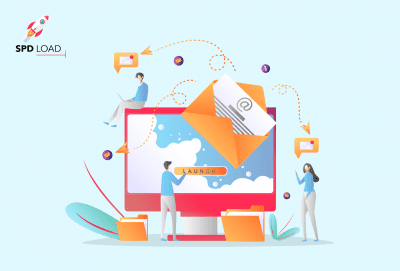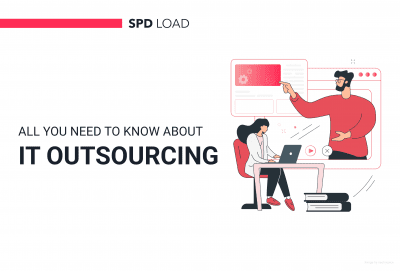Factors Affecting Android App Development Cost: Guide
- Updated: Nov 10, 2024
- 15 min
As a business looking to boost your digital presence, you must understand the costs of Android app development.
According to a recent Statista report, global mobile app revenue is expected to grow at a compound annual growth rate (CAGR) of 8.83% from 2022 to 2027, reaching an impressive $673.80 billion by 2027.
These numbers highlight the significant potential of investing in mobile applications.
To help you plan effectively, our guide answers the key question: “How much does Android app development cost in 2025?”
We provide an in-depth analysis of the factors that influence project budgets.
This guide is your roadmap to budgeting for your Android app development project, supported by the latest statistics and expert insights.
Before jumping into the topic, explore these practical app development tips to keep your project on track and on budget.
Contact us and let's discuss your app idea!
Getting to Understand Mobile App Development Cost
First, we need to understand what the Android app development cost is and why it’s important to know it before you start the development process.
The cost of Android app development includes all expenses involved in creating an Android app, such as planning, design, coding, testing, and launching.
It is important to estimate the cost of app development for several reasons:
Budget planning
When you know the estimated cost, you can allocate your budget effectively, ensuring you have enough funds to cover all stages of the development process.
Resource allocation
It allows you to plan for the necessary resources, including hiring developers, designers, and other professionals, as well as acquiring any required tools or software.
Project scope
A clear cost estimate helps define the scope of the project.
It ensures that all stakeholders understand what features and functionalities will be included within the budget.
Risk management
When you estimate costs upfront, you can identify potential financial risks and plan for contingencies.
This way, you reduce the chances of unexpected expenses that may harm the project.
Timeline management
Cost estimates often correlate with time estimates.
So, when you know the financial requirements, you can set realistic timelines and milestones for the project.
Investor confidence
If you’re seeking funding, a detailed cost estimate can demonstrate to investors that you have a well-thought-out plan and understand the financial requirements of your project.
Competitive analysis
A cost estimate helps you determine whether your pricing strategy is competitive and realistic with similar apps in the market. 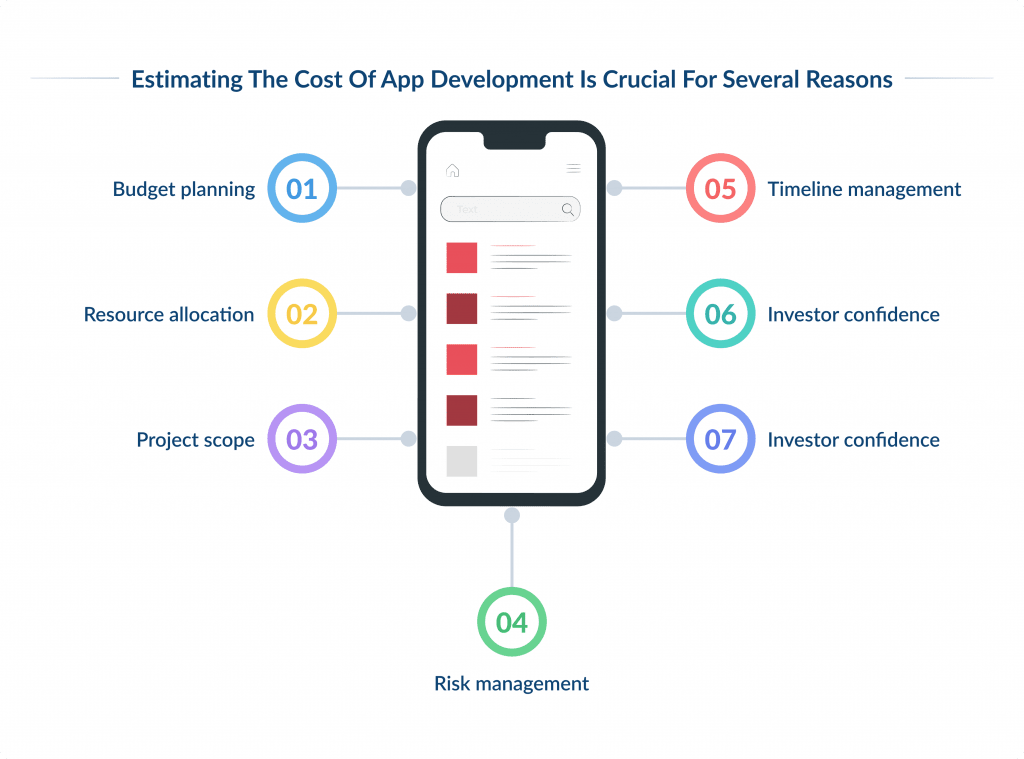
Now that we know why it is important to understand the Android app development costs beforehand, let’s move on to the factors that influence the development pricing.
Android App Development Cost Factors
Think of developing an Android app like opening a new coffee shop.
You must decide on the location, the interior design, the menu, and even the type of coffee machine you’ll use, each of which affects your budget.
Similarly, when developing an Android app, several factors come into play.
These are the app’s complexity, design, and features, and the location of your development team.
Need a reliable development team? Here’s your step-by-step guide to hiring a dedicated team in Ukraine.
Knowing these upfront will help you budget wisely and ensure your app’s success.
Learn how to create a successful app.
Now, let’s get into the Android app development cost.
App Complexity Levels
The cost of an Android app in 2025 can vary greatly based on several factors, including the app’s complexity.
Here’s a breakdown:
- Simple apps: basic features and minimal design. They cost at around $30,000. Ex. Weather Underground, Google Keep
- Moderate apps: more features, custom UI, and backend integration. They cost from $40,000 to $80,000+. Ex. Fitbit, Yummly
- Complex apps: advanced features, third-party integrations, and complex design. They can cost anywhere from $100,000 to $300,000 or more. Ex. Instagram, Uber.
Ready to build the next big social platform? Learn how to create an app like Instagram.
App Types and Categories
The type and category of your Android app also play a big role in the cost of development.
Different types of apps on the app stores have their own features, target users, security needs, and more.
IP masking for development security can be crucial to protect sensitive data during the development phase.
Explore our guide to cybersecurity trends and see what your organization needs to stay secure.
In 2025, some of the most popular categories are gaming, eCommerce, EdTech, and social networking.
While basic development costs are similar, the features and needs of your app can significantly affect the price.
Here are some examples:
| Industry | Updated Development Cost (USD) |
|---|---|
| Healthcare | $50,000 – $250,000 |
| Education | $40,000 – $200,000 |
| Retail | $30,000 – $150,000 |
| Media & Entertainment | $50,000 – $300,000 |
| Social Media | $60,000 – $400,000 |
These will help you budget better and avoid surprises along the way.
Play Store Deployment
Launching your Android application on the Google Play Store is a big milestone.
And it can also impact your overall app development budget.
Because deployment is not only uploading the app on the Play Store.
You must also ensure it meets all of Google’s guidelines and quality standards in order to get your app approved.
Google charges a one-time fee of $25 to register as a developer and publish your app on the Play Store.
But that’s just the beginning.
You’ll also need to budget for writing an app description, design screenshots, and ensuring your app works on different devices and screen sizes.
And don’t forget about the cost of updates and app maintenance.
These are crucial to keeping your app compliant with Google’s changing policies and to keep it running smoothly for users.
If your app doesn’t meet the guidelines and is rejected, you might have to pay extra to fix and resubmit it.
That is why you need to plan all these aspects to stay within your budget.
App Maintenance Requirements
Your Android app development cost doesn’t end with the app’s Play Store deployment.
You also need to consider maintenance.
It adds to the total cost of maintaining the front end and back end of Android apps.
Maintenance costs vary depending on the scope of development and changes required, so it’s best to find and hire dedicated mobile app developers and consult them for a quote.
Development Team Composition
The composition of your development team is a big factor in how much it will cost to build your Android app.
Your team will have a mix of developers, designers, project managers and QA testers, each with their own expertise.
The more experienced and specialized they are, the higher their rates and can increase the overall cost of your project.
For example, a senior developer who is good at complex coding might charge more than a junior developer.
But they can also work faster and solve problems better, so you’ll save in the long run.
If your app requires advanced features you might need to bring in extra experts like backend developers or security specialists which will add to the cost.
The size of your team matters, too.
A bigger team can get the job done faster but will also require a bigger budget.
Finding the right balance between the skills and size of your team and the requirements of your project is the key to keeping costs under control.
According to Arc.dev, FullStack Blog, and InApps, the hourly rate for app development in the US is around $100 per hour.
Here are some approximate costs of hiring specialists for app development:
Android App Development Cost Based on Development Team Size
| Cost Factors and Requirements | Simple App | Medium App | Complex App |
|---|---|---|---|
| Development time | 4-6 months | 8-10 months | 10-15 months |
| Developers | $30,000-40,000 | $50,000-60,000 | $100,000+ |
| DevOps | $2,000-4,000 | $5,000-7,000 | $10,000+ |
| Solution Architect | $1,000-3,000 | $5,000-8,000 | $9,000+ |
| QA Specialist | $8,000-10,000 | $15,000-20,000 | $20,000+ |
| Business Analyst | $2,000-3,000 | $5,000-8,000 | $8,000-10,000 |
| UI/UX Designer | $4,000-5,000 | $5,000-7,000 | $10,000-15,000 |
| Project Manager | $5,000-7,000 | $10,000-15,000 | $10,000+ |
| Total | $52,000 – $72,000 | $95,000 – $125,000 | $167,000+ |
UI/UX Design
Design is a crucial and one of the most costly app development expenses.
The design of the user interface (UI) and user experience (UX) will greatly impact the complexity and cost of development.
The app’s design cost can be calculated separately from the overall development cost.
Here’s a breakdown of what you might expect:
Initial design and conceptualization
At this stage, designers map out the overall look and feel of the application.
For a simple app, this might involve basic mockups and wireframes, which would cost around $3,000.
However, if your app is more complex and requires detailed wireframes and user flow diagrams, this stage can cost up to $12,000.
User Experience (UX) design
UX design identifies how users will interact with your Android application.
For example, doing user research and creating personas for a shopping app will add around $5,000 to your cost.
If you’re building a more complex app, like an enterprise tool with multiple user roles and workflows, the UX design can cost up to $25,000 due to the research and planning involved.
User Interface (UI) design
The UI design is about how the app looks.
If you build an app with a simple design, for instance, a note-taking app, it will cost around $12,000.
However, because of the level of detail and creativity required, the design cost can go up to $40,000 for a more elaborate project like a social media app with custom animations and graphics.
Adaptability and responsive design
When developing an Android application, it is important to make sure that your app looks good on different devices and screen sizes.
This will add to the cost.
The responsive design of a basic app may cost you an additional $4,000.
However, for more complex apps, such as games or apps with custom layouts, the cost can go up to $10,000 to ensure they work well across different screen sizes.
Custom animations and graphics
Basic animations will add around $3,000 to your budget.
Advanced animations or custom graphic designs will cost $15,000 or more depending on how intricate the graphics need to be. 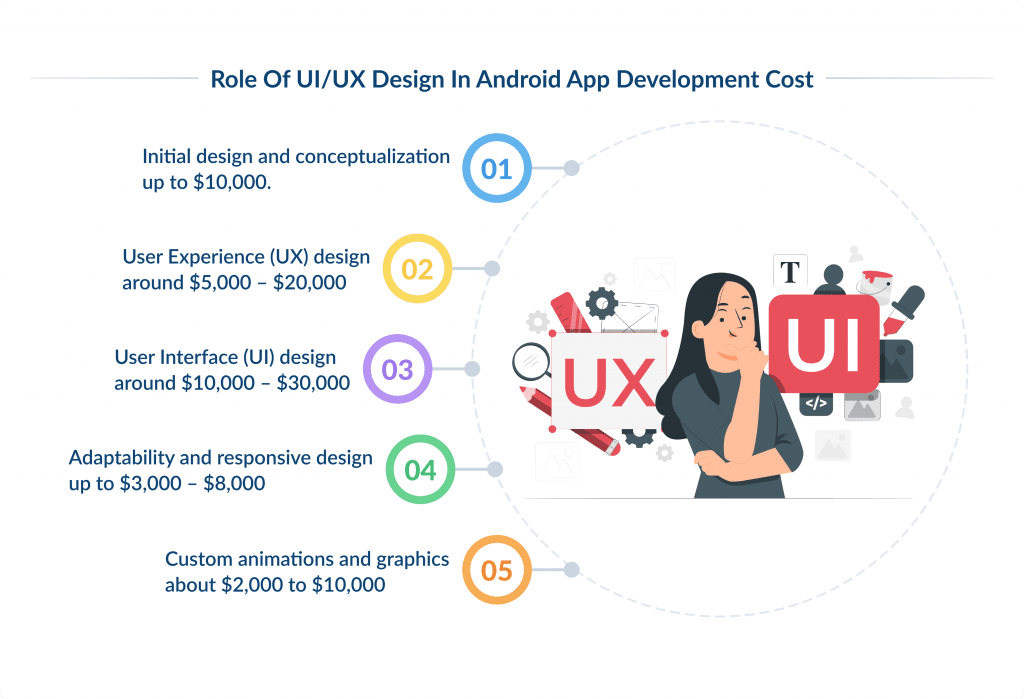
User testing and iteration
Testing how users interact with your app is key.
Regular usability testing may cost up to $6,000, depending on the app’s complexity, of course.
If you need more extensive testing like A/B testing and multiple rounds of user feedback for your complex app, the cost can go up to $18,000.
Integration with third-party services and APIs
In most cases, your app won’t just exist on its own.
You might need to integrate with third-party services like authentication systems, payment services, face recognition, etc.
This will also add to the final app development cost.
Simple integrations can be around $5,000.
For more advanced integrations like payment processing or real-time data synchronization, you may pay $15,000 or more.
Compliance and Accessibility
To meet basic accessibility standards, you will need to add around $4,000 to your development cost.
If your app needs to comply with industry-specific regulations, like HIPAA or advanced accessibility standards, the cost can go up to $12,000. This includes thorough testing and modifications.
Discover the best HIPAA-compliant chat apps to ensure your conversations meet strict security standards. 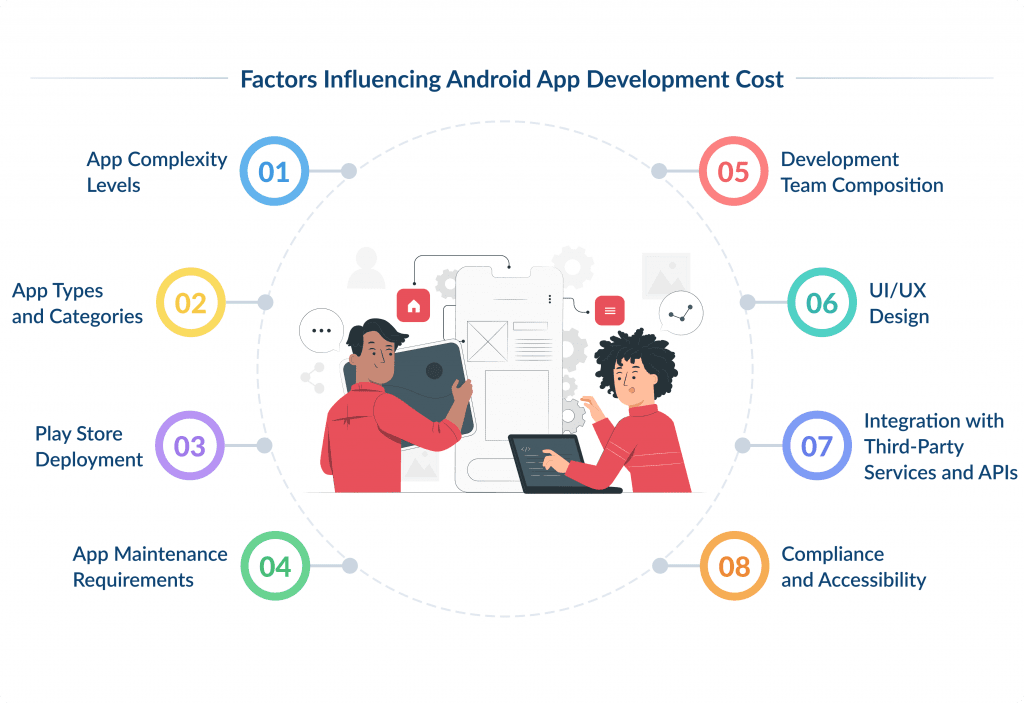
Ever wondered how to keep your customers coming back? Discover how car wash app development can help you create a seamless experience that keeps them happy and engaged.
Android App Development Cost By Stage
Now that we have explored the factors that affect Android app development cost let’s break down the app development process and see the prices of each one.
Knowing how much each stage of app development costs helps companies plan their budgets wisely.
Here’s a simple breakdown of the main stages and their average costs as of 2025:
1. Discovery Stage (10-15%)
- What it is: Discovery stage is where the groundwork happens. It includes market research, understanding user needs, and defining project requirements.
- Cost: Around 10-15% of the total budget.
2. Design Stage (20-25%)
- What it is: This stage focuses on creating the look and feel of the app. It involves designing the UI and UX, including wireframes, prototypes, and mockups. If you don’t have designers in your team, you can always outsource UI/UX design to professionals from SpdLoad.
- Cost: About 20-25% of the budget.
3. Development Stage (40-55%)
- What it is: This is the core part where the app is actually built. It includes coding, setting up the backend infrastructure, and integrating all necessary features.
- Cost: The largest chunk, approximately 40-55% of the budget.
4. Testing Stage (15-20%)
- What it is: This stage ensures the app works correctly. It involves various types of testing to find and fix bugs, making sure the app runs smoothly on different devices.
- Cost: Typically 15-20% of the budget.
5. Deployment Stage (5-10%)
- What it is: This final stage includes launching the app on app stores and providing ongoing maintenance and updates to keep the app functional and current.
- Cost: Around 5-10% of the budget.

It is important for companies to understand these stages and their associated costs throughout the entire app development process so they can allocate their funds appropriately.
Android vs iOS App Development Cost
You might already have your favorite platform. However, it is important to set your personal preferences aside when developing an app for people.
Instead, focus on the preferences of your target users to give your app the best shot at success.
Of course, several big-picture and detailed factors must be considered.
We’ll explore them further to help you choose the platform that’s right for your budget and goals.
But overall, keeping your users in mind makes you more likely to make the right choice.
Let’s get into it.
What is Android?
Android is an operating system created by Google that is widely used by manufacturers such as Samsung, Motorola, Huawei, and OnePlus.
It’s widely used because of its open-source nature and the flexibility it offers developers for customization.
Android apps are primarily launched on the Google Play Store.
They can also be distributed through the Amazon App Store and other platforms.
What is iOS?
iOS is Apple’s mobile operating system.
It is popular and loved for its sleek design and seamless integration with the Apple ecosystem.
iOS is exclusive to Apple devices.
iOS apps are typically launched on the Apple App Store.
Several factors come into play when comparing Android and iOS app development costs.
Here are some key points to consider:
Development Complexity
- Android: Android development can be more complex since there are a lot of devices and screen sizes. This fragmentation requires extensive testing and optimization.
- iOS: iOS development is generally more streamlined as it targets a limited number of Apple devices. Hence, the development process is more predictable and consistent.
Programming Languages
- Android: Primarily uses Java and Kotlin. Kotlin is now the preferred language for Android app development because it has many modern features and full interoperability with Java. We also use it for app development in Spdload.
- iOS: Uses Swift for app development. This language is known for its performance, safety, and developer-friendly syntax.
Development Tools and Environment
- Android: Uses Android Studio, which offers a robust set of tools for development.
- iOS: Uses Xcode, which provides a comprehensive suite of tools for iOS development.
Market Share and User Demographics
- Android: Holds a larger market share globally, over 70%. Especially in developing countries. According to Statista, Android has over 85 percent market share in multiple countries like USA, UK, China, and Indonesia.
- iOS: More popular in developed economies and among users who spend more on apps.
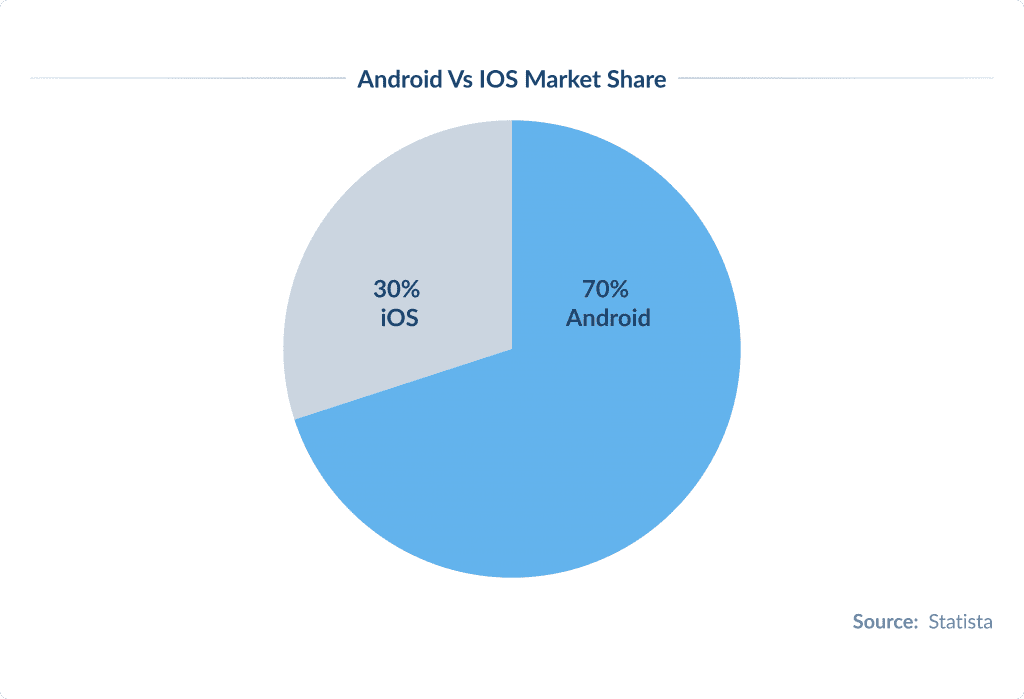
Development Costs
- Android: This can be more expensive since there is a need to optimize the app for numerous devices.
- iOS: Generally more cost-effective as there are fewer devices to consider.
Monetization Potential
- Android: The user base is bigger than iOS. However, users tend to spend less on apps. The mobile app revenue generated from Android apps is projected to exceed $600 billion by 2025.
- iOS: iOS users spend 7X more money on apps than Android users. Because Airbnb and Uber require users to pay to use their services, they launched first on iOS.
App Store Fees
- Android: Google Play Store charges a one-time developer fee of $25.
- iOS: Apple App Store charges an annual fee of $99.
Security and Updates
- Android: Apps are more open and flexible but can be less secure due to their open-source nature.
- iOS: More controlled and secure environment, with regular updates directly from Apple.
Ultimately, the choice between Android and iOS mobile app development comes down to what works best for your goals and budget.
If you want to reach a wide global audience, an Android app might be the way to go. However, it can be a bit more complex and costly.
On the other hand, if you’re looking for a smoother process and users more likely to spend on your app, iOS could be the better choice.
Here’s a look at the best iOS app development tools for creating standout mobile apps.
Get a strategic MVP to mitigate risks.
How to Reduce Android App Development Cost
One thing is for sure: regardless of the path you choose, developing mobile apps is costly.
But don’t worry. There are some strategies and tips to reduce mobile app development costs without sacrificing quality.
Let’s explore them.
Requirement Documentation
Requirement documentation is a smart way to keep your Android app development cost under control.
This is a roadmap for the entire project: what the app should do, how it should look, and how it will work behind the scenes.
With well-put documentation, you minimize the chances of miscommunication between you and your development team.
This minimizes costly changes and delays along the way.
For example, if you’re building an eCommerce app, your documentation should specify features like product search, payment options, and user accounts, along with details of how each feature should work.
This way, the mobile app developers know exactly what’s expected, reducing the chances of surprises that can blow up your budget.
If you don’t know where to start, use these 6 best practices to scale your e-commerce business.
Good documentation also helps everyone on the team stay on the same page and facilitates a smoother Android app development process.
It’s a reference point that keeps the project focused and avoids adding unnecessary features that can increase cost.
Feature Prioritization
Another important thing that can reduce app development costs and time is to define the project scope.
This is key to avoiding adding unnecessary features or functionalities that can increase development costs.
A clear scope outlines the app’s core requirements and keeps the development process focused.
For example, if you’re developing a fitness app, prioritize features like workout tracking and user profiles.
Avoid complex features like social networking unless they’re critical to its success.
This way, you prevent scope creep, where additional features are added mid-project, leading to delays and cost increases. 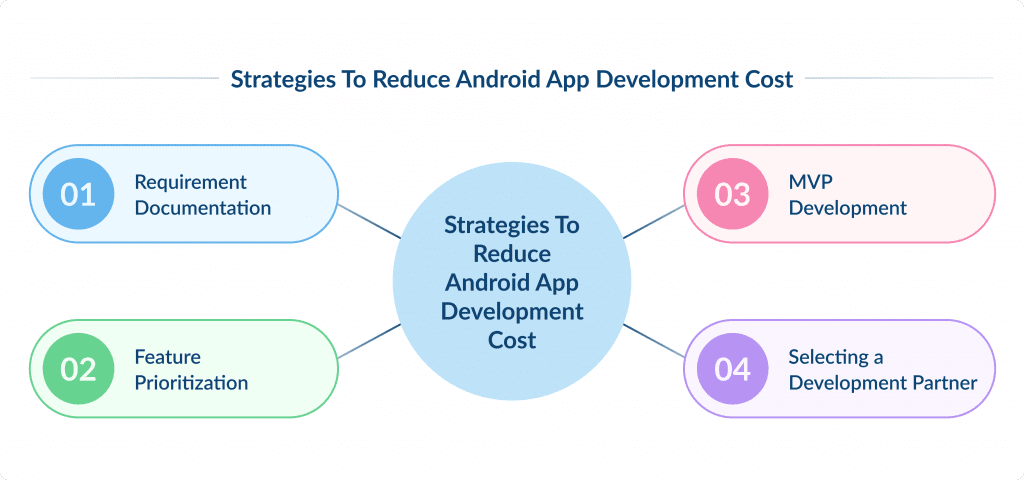
MVP Development
Start with an MVP in software development and include only the most essential features. This way, you can test the market and get user feedback before investing in more features.
When you focus on core functionalities you can reduce the initial development cost and get your app to market faster.
For example, if you’re building a food delivery app, start with basic features like menu browsing and order placement.
Leave advanced features like in-app chat or loyalty program for later updates.
This way, you can test the market with minimal investment and build more features based on user feedback.
Whether you’re a startup or a seasoned pro, this guide on MVP design will save you time and money.
Choosing a Development Partner
The choice of your Android app development team plays a big role in the overall cost.
You have several options: hiring an Android app development company, local team, in-house team or a freelance Android developer.
An Android app development company is often the best choice for building high-end apps with advanced features and functionalities.
Here’s a rough idea of what your app development cost will be with an outsourced development team (learn more about what is IT outsourcing and its benefits).
Outsourcing to regions with lower labor costs can save you a lot.
Countries like India, Eastern Europe, and Southeast Asia have skilled developers who charge less than their counterparts in North America or Western Europe.
Here you will find more information on top 1o countries to outsource software development.
For example a developer in the U.S. might charge $100 to $150 per hour and a developer in Ukraine might charge $40 to $60 per hour and that’s a huge cost saving without compromising on quality.
Based on a survey by Goodfirms, below is the table that indicates how much a mobile app developer charges hourly in different countries:
| Region | iOS (Avg. $/Hr.) | Android (Avg. $/Hr.) | Cross-platform (Avg. $/Hr.) |
|---|---|---|---|
| Canada | 90–120 | 80–140 | 90–120 |
| USA | 60–120 | 60–120 | 60–130 |
| Latin America | 28–90 | 28–90 | 40–160 |
| UK | 60–75 | 60–75 | 55–75 |
| Europe | 35–55 | 35–55 | 30–50 |
| Ukraine | 40–78 | 38–60 | 40–78 |
| South Africa | 45–80 | 40–80 | 40–80 |
| India | 22–90 | 15–25 | 20–30 |
| Southeast Asia | 23–55 | 30–45 | 30–45 |
| Asia | 25–35 | 20–30 | 25–35 |
| Australia | 90–120 | 100–120 | 90–120 |
Why Choose SpdLoad for Android App Development?
Our mobile app development company has been working with startups and enterprises all over the world for over 1o years now.
If you are looking for a development partner to create a modern Android app that your target audience will enjoy using, we can do exactly that!
We understand you might need to evaluate our skills and experience first, so feel free to look through our case studies.
There, you will find our recent projects along with critical information on project details, challenges faced and solutions we provided, and, of course, key deliverables our clients got.
If you don’t have time to look for projects in the key studies, here are some app examples we have developed recently.
The first one is a recruitment app designed for fast-food employees.
We successfully created a mobile application for employees, a web version for employers, and a web-based admin panel for our client.
Our solutions streamlined the job application process, provided a centralized platform for job information, and ensured professional implementation.
The client now offers a user-friendly and efficient way for fast-food employees and employers to connect, creating a friendly community with convenient job opportunities.
Read the full recruitment app development case study. 
Another application we developed is an innovative app designed to leave verified reviews about cafes and restaurants.
The client contacted us to develop a complex application similar to Yelp.
They wanted an app that encouraged customers to provide relevant feedback on food, service, and other aspects, helping businesses expand their customer base through genuine reviews.
We integrated innovative features like receipt scanning and created a user-friendly design. This helped our client achieve its goal of providing a platform for honest customer feedback.
Learn more about this restaurant reviews app development process. Check out our comprehensive restaurant app development guide. 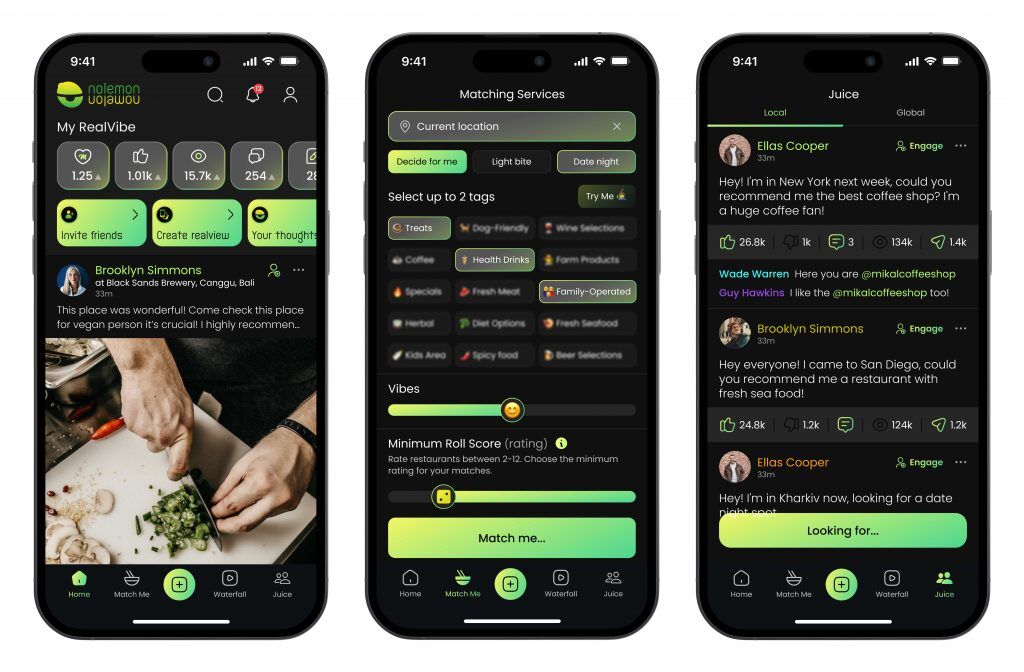
We hope that this article on app development cost breakdown was helpful to you.
Let’s get in touch to discuss your Android app idea and see how we can wrap your vision into a modern feature-packed solution!
For companies looking to streamline hiring, choosing the best recruitment CRM can make all the difference in talent acquisition.





